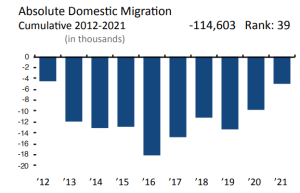While other states’ economies grow, Kansas’s continues to stagnate. In the recently released Rich States Poor States study for 2023, Kansas ranked 39th across all states on economic performance from 2011 to 2021. The most glaring issue was that Kansas ranked 42nd in non-farm employment growth. Over the decade, Kansas’s growth in this metric was 2.10% whereas the U.S. average was about 5%. Similarly, had a net loss of 114,603 residents from domestic migration while other states – such as #1 Florida – grew by the millions. GDP growth ranked slightly under the U.S. average as well.*
The difference between the top states for economic growth and Kansas is clear: those thriving have pursued tax reform to bolster their economies whereas Kansas has struggled and failed to implement meaningful, long-term change. Utah, for instance, was ranked #1 for GDP growth and employment growth from 2011 to 2021. Since 2008, the state has had a flat tax on income which is now down to a rate of 4.85%. In 2018, the Mercatus Institute ranked Utah in the top 10 for fiscal health, citing low levels of debt and reasonably well-funded state pension.
Similarly, Florida ranked #1 for domestic migration, with two third of residents of the state’s residents being new. Florida has no state income tax, the 11th lowest average state and local tax burden, and has kept the cost of utilities low to make the state more affordable. No payroll taxes and a low corporate income tax has made Florida a thriving place for big and small companies to do business in a low regulatory environment. Cities like Miami have seen massive business growth in new industries like digital finance and cryptocurrency from competitive tax rates and general enthusiasm towards drawing businesses into the state.
 Undergirding both Utah and Florida is limits on government spending. More on this being in direct contrast to Kansas below. But, its simply that the states the spend less tax less. For instance, states with an income-tax collected 52% state taxes per resident compared to states without an income tax. At the same time, these income taxing states spent 80% more per resident than states without an income tax.
Undergirding both Utah and Florida is limits on government spending. More on this being in direct contrast to Kansas below. But, its simply that the states the spend less tax less. For instance, states with an income-tax collected 52% state taxes per resident compared to states without an income tax. At the same time, these income taxing states spent 80% more per resident than states without an income tax.
Meanwhile, Kansas is stuck in a malaise. The Sunflower State has a top marginal income tax rate of 5.70%, which ranks middle-of-the-pack compared to states across the nation. The Tax Foundation says subsidies are one of the reasons that Kansas has the highest effective tax rates on mature businesses. The combined state and average local tax rates are the 9th highest in the country.
The Sunflower State ranks 30th in Economic Outlook – calculated from 15 variables varying from income and sales tax burden to minimum wage. Kansas ranked middle-of-the-pack when it came to tax burden, but got serious knocks when it ranked 3rd worst for public employees per 10,000 residents – a sign of over-governance and high taxation.
 SB 169’s tax reforms could move Kansas up on the Outlook list though. The bill contains a flat tax proposal a 5.15%, eliminating the food sales tax, and phrasing out the taxation cliff on Social Security benefits, among other tax reforms.
SB 169’s tax reforms could move Kansas up on the Outlook list though. The bill contains a flat tax proposal a 5.15%, eliminating the food sales tax, and phrasing out the taxation cliff on Social Security benefits, among other tax reforms.
Kansas has the opportunity this year to turn a poor economic track record into the start of something new and competitive with others. But it comes with balancing spending and thinking of how taxpayer dollars can stay in people’s wallets versus a tax-and-spend mentality.
*The graphs in this piece were sourced from the Rich States, Poor States Report.





